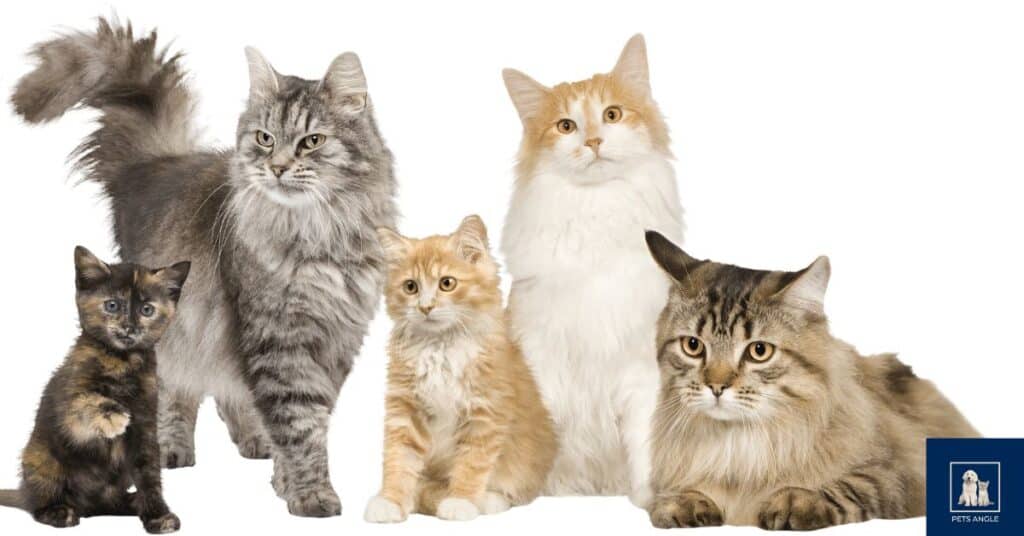If you like to spend your days indoors and want a dependable companion to keep you company, look no further than felines.
However, not all cats are suitable for indoor use because their wild and hunter instincts are not tamed in the same way.
The volume of time you have to spend with the cat, the care required to keep the cat healthy, your personality, and the cat’s lifestyle are all things to consider before getting one.
Your views on the questions will guide you in determining which breed is best for you.
To help you decide, we’ve compiled a list of the top indoor cat breeds:
1. SCOTISH FOLD: Scottish Folds are amiable, intelligent, and talkative home pets. These cats have a balanced character, which means they aren’t overly active or energetic.
Scottish Fold cats appreciate human or animal companionship and are quite patient with children. They also don’t mind being the sole pet in the house and will accept all of the attention you can provide. This cat breed gets along nicely with other canines.
2. SPHYNX: Because of its baldness, the Sphynx is a widely recognized cat breed. Sphynx kittens are highly social and affectionate, and they will grow up to be a cat who enjoys hanging out with you at home. This breed is very intelligent and curious and will gladly receive you anytime you return home.
A Sphynx, being highly active and lively, is quite active in the house, demonstrating to be a fantastic companion and preferring to be around people.
You should also consider getting a feline companion if you’re thinking about having a Sphynx. It requires regular grooming sessions because it lacks fur to absorb natural oils.
3. DEVON REX: they are clever, active, and cheerful. These social animals get along well with children, only that the infants need to understand how to appropriately engage them. Devon Rex cats enjoy being in the company of pets and other people. The Devon Rex cat is an easy-to-care-for pet. Your Devon Rex cat is content to be an in-house cat; however, its boundless energy is best expended outside.
4. SIAMESE: They are the friendliest feline breed, quickly getting along with youngsters and other pets. While being excellent in-house felines, the Siamese craves human connection by reclining on knees or snuggling in bed with its owners.
Don’t go for a Siamese cat if you spend too much time outside the house. Siamese cats have some dog-like characteristics, such as a desire for constant connection and a desire to engage.
5. HIMALAYAN: The Himalayan, often known as Himmy, is a variant of the Persian cat. Himmy is typically a moderate cat with a large and heavy bone shape. It can appear rather massive due to her quantity of fur. The Himalayan is a mixed breed similar to the Persian but differs in that it has points on its limbs.
These lovely cats can have kitten-like spurts of activity, frantically dashing through the loungeroom on their next expedition, and they make wonderful companions for owners who pay attention to diet and provide them with sufficient activity, interaction and cleaning.
6. PERSIAN: a pleasant, gregarious, and lovable cat variety that is one of the oldest. The Persian cat’s calm and charming demeanor will usually endear it to you. This cat breed enjoys being pampered, but it dislikes noise, so some cat enthusiasts say it would not be a good choice for a family with children.
7. RAGDOLL: this is a natural indoor cat because of how it welcomes visitors into your home. The Ragdoll cat is a sweet and friendly breed that is less energetic and adventurous than many other cat varieties.
Ragdolls are excellent indoor cats and make excellent lap cats. When you lift them, they become limp and have low energy levels.
Due to its weak street smarts and extreme peacefulness, keeping your Ragdoll cat home is preferable to safeguard their safety.
What You’ll Need to Take Care of an Indoor Cat
a. Space
b. Water and food
c. Cat carrier
d. Litter receptacle
, e. Cat blankets
f. Scratching post
Why Do People Prefer Indoor Cats?
Indoor cats face fewer physical dangers than those exposed to the outside world, and as a result, many enjoy longer and healthier lives.
They are largely protected from surroundings crises between neighbors’ cats, resulting in hostile feline confrontations and injuries.
Risk Factors for Indoor Cats’ Health
- Most cat owners know that keeping their cats home is a safer alternative than allowing them to roam freely outside.
- Being overweight can heighten obesity tendency. Diabetes can ultimately result.
- Lower Urinary Tract Disease in Cats.
- Stress.
- Separation Anxiety
- Dangers in the home
How to Make Your Indoor Cat Content
1. Because the cat is an obligate carnivore, you must provide the indoor cat with a protein-rich diet.
2. Keep the feeding area and the litter box separate to maintain maximum hygiene.
3. Provide enough room for the cat to leap around and play. While both are essential for a cat’s health, vertical space is more necessary since cats prefer high-altitude locations where they may climb and exercise their limbs.
4. Keep the indoor temperature warm to keep the cat’s thermoneutral temperature. During the day, you can put the cat’s beddings in the sun or near the heater.
5. Spend a lot of time with the cat to keep it occupied.
6. Keep the cat’s litter box clean to ensure good health and to be aware of the cat’s particular preferences. Remember, cats don’t share a space where another cat has made a mess.
7. Make sure the cat has some toys to play with. The presence of toys can assist the cat in exercising its hunting instinct.
8. Using a puzzle feeder helps keep a cat’s life interesting.
9. Cat grooming activities such as combing and brushing their coats can make cats more lovable to humans.

